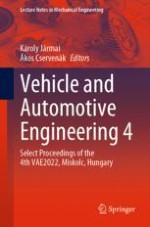2023 | OriginalPaper | Chapter
Calculation Methods and Measurement of the Heating of Small Plastic Gears
Authors : Imre Marada, János Bihari
Published in: Vehicle and Automotive Engineering 4
Publisher: Springer International Publishing
Activate our intelligent search to find suitable subject content or patents.
Select sections of text to find matching patents with Artificial Intelligence. powered by
Select sections of text to find additional relevant content using AI-assisted search. powered by
